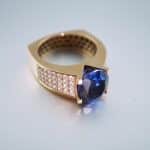Creating an indoor climbing wall for your children not only encourages physical fitness and coordination but also fosters a sense of adventure and accomplishment. As you begin this exciting project, you may find yourself wondering about the best practices to follow. This guide will walk you through the process of designing and building a fun, safe, and kid-friendly climbing wall inside your home.
Choosing the Ideal Space for a Kid’s Climbing Wall
Before you start sketching designs or buying materials, you need to select the right space in your home. This decision hinges on several factors, including the room’s size, the wall’s structural integrity, and the safety measures that can be implemented.
A lire aussi : How to Choose the Perfect Ergonomic Rocking Chair for a New Parent’s Nursery?
The wall should be high enough to challenge the child but not too high to pose a significant fall risk. A height of 8-10 feet is usually suitable. Additionally, the chosen wall should be sturdy enough to withstand the weight and movement of a climbing child.
It’s important to keep safety in mind. Make sure there’s enough space around the climbing area to install crash pads or a soft mat. This will cushion any potential falls. Also, ensure that the room has enough lighting, and there are no dangerous objects in the vicinity of the climbing wall.
Sujet a lire : What Are the Best Plants for Creating Privacy on an Urban Balcony?
Materials and Equipment Needed
Once you’ve identified the perfect spot, it’s time to gather your materials. The primary components of an indoor climbing wall are the wall itself, usually made of plywood, the climbing holds, and the mounting equipment.
Plywood is a common choice due to its strength and durability. Two sheets of 3/4-inch plywood, each measuring 4×8 feet, should be sufficient for a small, children’s climbing wall.
Climbing holds are the shapes that climbers grip or step on. They come in different shapes, sizes, and colors. For a child’s wall, choose holds that are easy to grip and footholds that are wide enough for small feet.
The mounting equipment includes the drill, screws, and T-nuts. You’ll need a power drill to make holes in the plywood. The screws will secure the plywood to your wall, and the T-nuts will attach the holds to the plywood.
Laying Out and Installing the Wall
Designing the layout of your climbing wall is a critical step. The arrangement of the holds should be both fun and challenging. Start by sketching a design on the plywood before you drill any holes. You can involve your child in this process for a more personalized design.
Begin with easy hold placements for your child to get the hang of climbing, then gradually increase the difficulty as their confidence and ability grow. Remember to space out the holds evenly to allow for a wide range of movement.
Once your design is complete, it’s time to drill the holes. Drill through the locations you marked on the plywood, ensuring you have enough holes for all the holds you plan to install.
After drilling, mount the plywood on your wall using sturdy screws. Ensure the plywood is secure and stable before proceeding to the next step.
Attaching Climbing Holds
Attaching the holds to your climbing wall is the final step in the building process. This is where your design starts to come alive.
Each hold will have a bolt hole. Line up the hole with a pre-drilled hole on the plywood, insert a T-nut from the back of the plywood, and screw the hold into place.
Remember, the placement of your holds will determine how challenging the climb will be. For younger children, place the holds closer together and at lower heights. As the child grows, you can rearrange the holds to create more challenging paths.
Safety Measures
No matter how well designed or built your indoor climbing wall is, safety should always be a priority. Installing a thick, soft mat or crash pads beneath the climbing wall is a must to cushion any falls.
Teaching your child proper climbing techniques will also go a long way in preventing injuries. Always supervise children while they are climbing and set some ground rules for safe play.
Additionally, routinely inspect the wall for any loose holds or structural issues. Regular maintenance will ensure the climbing wall remains safe and fun for your child to use.
Building a children’s indoor climbing wall can be a rewarding project. It promotes physical fitness, provides a unique play area, and can even be a fun DIY activity for the whole family. By carefully choosing a space, gathering the right materials, and following a considered design and installation process, you can create a safe and exciting indoor gym for your child.
Incorporating Additional Features
To further enrich your child’s climbing experience, you may consider adding extra features to your indoor climbing wall. Some of these additional elements could include monkey bars, a bouldering wall, or even a mini indoor playground combined with the climbing wall.
Monkey bars not only add an extra level of fun but also contribute to developing upper body strength and dexterity. They can be installed across the top of the climbing wall to make the play area more dynamic and engaging. Ensure to install them at a height suited for your child’s stature and capabilities.
A bouldering wall can be a fantastic addition to your indoor climbing setup. It is essentially a horizontal climbing wall, allowing kids to climb sideways. This kind of wall enhances spatial awareness and flexibility. Remember to have enough matting or padding beneath the bouldering wall to ensure safety.
In multi-purpose playrooms, combining the climbing wall with an indoor playground can be an excellent way to engage kids in various forms of active play. You could add swings, a slide, or a tunnel to the climbing area to create an indoor play gym. It’s crucial to ensure all these structures are securely fastened and safe for use.
Conclusion: The Benefits of a DIY Indoor Climbing Wall
Creating an indoor climbing wall for kids is not just about designing a play zone. It’s an investment in your child’s health, fostering physical activity and encouraging an active lifestyle.
A DIY indoor climbing wall is more than just a play area. It can serve as a tool that aids in the development of gross motor skills, coordination, strength, and confidence. Whether it’s a simple rock wall or a complex wall with monkey bars and a bouldering area, a climbing wall offers endless opportunities for active play in the safety and comfort of your own home.
Moreover, the process of designing and creating the climbing wall can be a great family bonding experience. It allows children to participate in a meaningful project, teaching them about planning, hard work, and satisfaction of seeing a project through to completion.
In conclusion, an indoor climbing wall is a worthwhile project for any family seeking to promote physical activity and adventurous play within their home. By following safety guidelines, being creative with your design, and including engaging elements like climbing holds and monkey bars, you can create a kids’ playroom that offers both fun and fitness. Regular inspections and maintenance will ensure that your indoor climbing wall will serve as a favorite play gym for your child for years to come.






